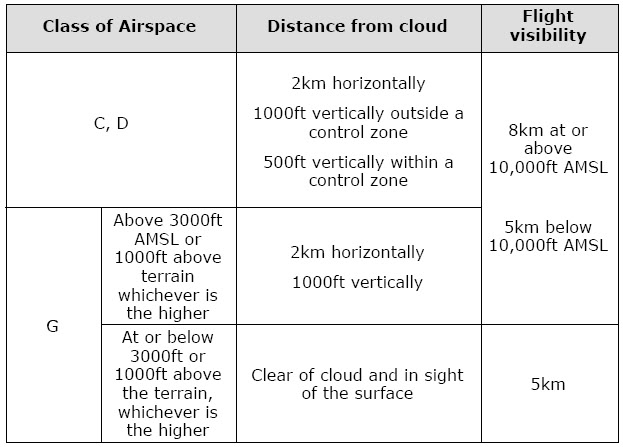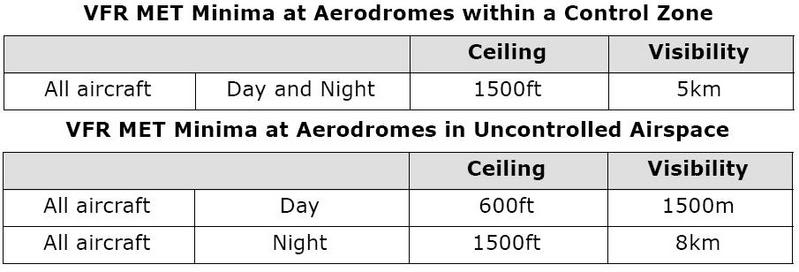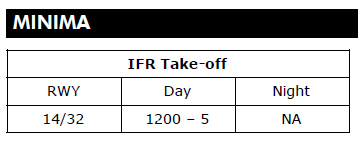IFR versus VFR
Visual Flight Rules (VFR)
The VFR is the set of rules which govern flying on a nice sunny day, between airports or a local scenic flight. When filing a flight plan on VATSIM, include a departure aerodrome and an arrival aerodrome, and in the route field, enter your route or intentions. Since VFR flights operate in VMC (Visual Meteorological Conditions), the route may read like "NZAA SkyTower Beachlands NZAA".
You must maintain VMC throughout a VFR flight. This can be hard to judge in the flight simulator environment; however, the following tables are used in the real world and are included here for guidance.

Exceptions:
- A helicopter may operate in Class G airspace with less than 5km visibility if operated at a speed that will give an opportunity to observe other traffic or any obstructions to avoid collisions.
- An aircraft performing agricultural operations may operate in Class G airspace with a flight visibility of less than 5km but not less than 1500m.
- An aircraft performing flight instruction may operate within a low flying area with a flight visibility of less than 5km but not less than 1500m.
Aerodrome minima: Except for a flight under "Special VFR", a pilot is not permitted to take-off or land an aircraft or fly in the vicinity of an aerodrome under VFR when the flight visibility and the cloud ceiling is less than the minima prescribed.

Special VFR: Special VFR is only given when certain minima are present and can only be issued within an aerodrome control zone (CTR). This will change the separation rules applicable for a VFR flight from an ATC point of view. From a pilot's point of view, they will be permitted to conduct a VFR flight with less flight visibility and lower cloud ceiling than under general VFR rules. Special VFR allows the pilot of an aircraft to perform a VFR operation within a control zone in weather conditions below those commonly prescribed, provided the operation is performed:
- in compliance with an ATC clearance and ATC instructions
- by day only
- clear of clouds
- with the ceiling and visibility detailed in the following table, except that helicopters may operate with lower minima if they are operated at a speed that will give adequate opportunity to avoid collisions
- in an aircraft equipped with a two-way radio capable of communicating with ATC at the appropriate frequency.
Within Class C and D airspace, all SVFR flights are separated from each other and from IFR flights.

Please visit the NZ AIP ENR1.2 - VFR Procedures for more information on VFR rules.
IFR
IFR (Instrument Flight Rules) is a set of rules to allow aircraft to operate in Instrument Meteorological Conditions (IMC). These rules contain specific criteria for most flight elements; for example, it details the minimum instruments required to be fitted to your aircraft to enter IMC. On VATSIM, most people conduct flights IFR from aerodrome to aerodrome. Some users fly jets with sophisticated flight management computers and automatic pilot systems, whereas some pilots may fly a small Cessna IFR over a much shorter route.
Instrument Meteorological Conditions (IMC) refers to the weather conditions under which IFR flight is required. An IFR flight will generally stay an IFR flight whether it enters cloud or poor visibility or not. Flights are conducted IFR every day, even on the sunniest of days. IFR does allow the flights to operate in IMC - that is, in cloud or conditions of poor visibility (less than those minima described above).
IFR Departure Minima: Sometimes, the weather conditions may be so poor that even IFR flights may not depart an aerodrome. The take-off minima is published on the aerodrome chart at IFR aerodromes in New Zealand. If no minima are published, a general minimum of 300ft ceiling and 1500m visibility applies. If it is worse than that, then you must delay your departure until the weather improves.
The above minima show that IFR Take-off is available on Runway 14/32 by Day only when the cloud ceiling is not below 1200ft and the visibility is not less than 5km.
IFR Approach Minima: When on arrival at an airport in poor weather, you will be on some instrument approach. This will typically be an ILS (Instrument Landing System). An ILS has many advantages, the first being it guides the pilot both laterally and vertically right down to touchdown for some larger aircraft. ILS is considered a precision approach because of both lateral and vertical guidance. Other approaches available in New Zealand include VOR/DME, NDB/DME and RNAV/RNAV-RNP. All of these approaches are considered non-precision approaches. Precision approaches offer a lower minima than non-precision approaches (generally speaking - there are a few exceptions with RNAV-RNP).
Below are a few examples from New Zealand approach charts that show the different minima available.
For Category I approaches under all categories (A, B, C, D), the lowest an aircraft may fly this ILS approach is 215ft AMSL (200ft AGL). At that point, the aircraft must have at least 800 metres visibility (or have the runway RVR reported as at least 550m). If you go down one line, you can see that these minima increase if the runway lights are not working (LIH ALS U/S). If the glideslope has failed, but the localiser is still operating, the minima change again (LOC/DME). If the aircraft intends to circle off the approach (circling for the other runway or perhaps for IFR training), then the minima differ depending on the size category of the aircraft.
What should I fly?
Depending on your skill level and knowledge, you can choose either one. If you feel like going for a scenic flight around Lake Taupo, you most likely will file to fly VFR. If you are flying from Christchurch to Auckland in an Airbus A320, you will file your flight plan as IFR. Enjoy your flight on the VATSIM network within VATNZ airspace. If you have any comments or questions, please get on the VATNZ Forums and ask away. All of our staff and members are knowledgeable and will provide the information you require.



